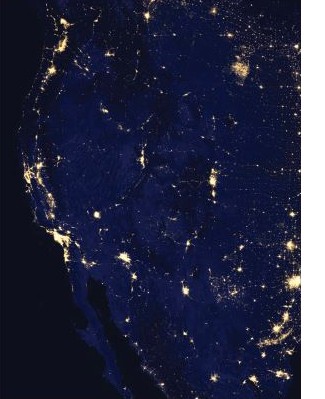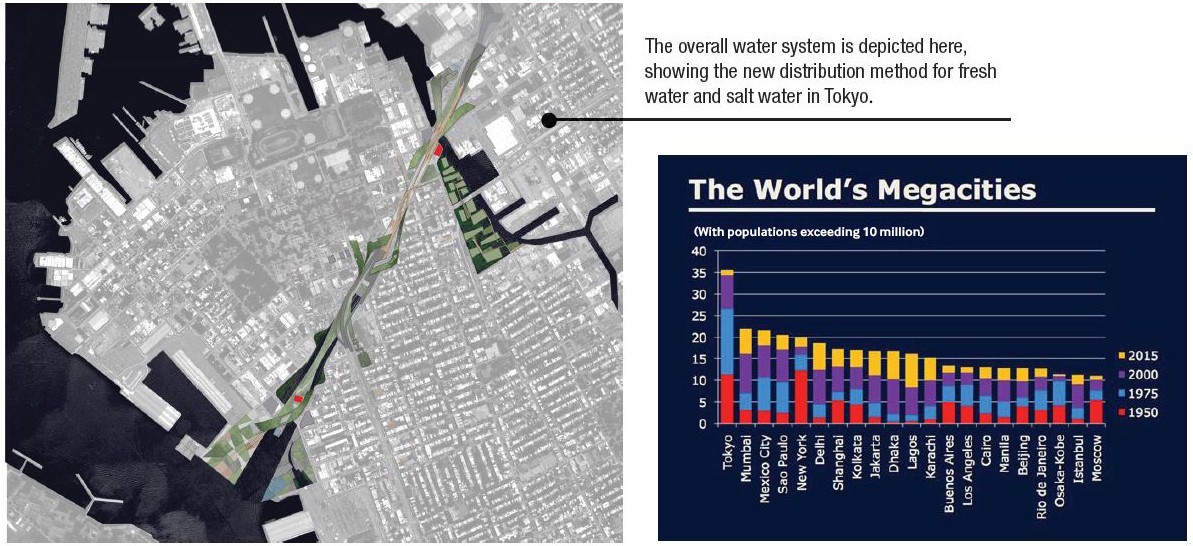Megacities: Striving for Sustainability

By Kerry Connell
What is a City?
If you are like most people, you might say that a city is a big town with large buildings. Other components of a city are sidewalks, subways and streetlights — all inanimate objects. Cities, and the infrastructure that supports them, are not usually considered to be living things, but, in many ways, they almost are. Cities expend energy, they use water and they produce waste. And if a city is a living thing, then a megacity is an even greater animal.
Megacities are metropolitan regions that incorporate a city (of two or more converging cities) and include a series of connected infrastructure systems. To be considered a megacity, the region’s population must total at least ten million people. Most people who live in these megacities spend the majority of their time living and traveling within them, from suburban home to city office by commuter railway, car or other transportation. City dwellers may enjoy the luxury of walking to work, while people in adjacent suburbs or small towns may never even enter the city center. But they all make up the human factor that megacities require to function. And humans, who consume, produce and transport energy, resources and waste, are what bring life to cities and megacities.
Globally, scientists have identified 27 megacities as of 2010. Tokyo (37,900,000 people), Jakarta (30,326,103 people), Seoul (26,100,000 people) and Delhi (25,703,000 people) are the biggest, but megacities exist all over the world. Rome is generally considered the first very large city; by the end of the first century B.C., its population was more than one million. By 1900, London counted more than five million people. In 1950, New York City became the first human population center to pass ten million — the threshold for today’s megacity.
In 1800, just three percent of people lived in cities, but today, about 3.2 billion people, or nearly 50 percent, are city dwellers. The United Nations predicts that five billion people, or three in five, will live in cities by 2030. The number of megacities is expected to reach 37 by 2020. These regions generate 14.6 percent of our world’s total GDP, but they also consume a disproportionate percentage of resources. The rapid urbanization of modern megacities creates a strain on infrastructure that, if unabated, could easily lead to the failure of the very systems that brought the city about to begin with.

In addition to the many environmental challenges that such huge populations present, the limits that city conditions may place upon an individual’s ability to experience happiness and security can be vast. Insufficient housing and transportation that simply cannot keep up with growth can lead to the development of slum conditions within and around large cities. Homelessness, crime and other social ills tend to increase with population and with concentration. Educational services, health care systems and sanitation services that do not keep pace with population growth can result in less than ideal conditions.
But what about the purely environmental concerns that affect the life of the megacity organism and the world it inhabits? According to a study entitled “Energy and Material Flows of Megacities,” published in Proceedings of the National Academy of Sciences, the megacities of today are home to only 6.7 percent of the world's population, but they are responsible for nine percent of the planet’s electricity use, ten percent of its gasoline use and 13 percent of its solid waste generation.
Understanding the flow of energy and material through megacities is a necessary prerequisite to understanding how energy and material flow affects the global environment. In aggregate, the resource flows are consistent with the scaling laws that apply to cities. The study finds that electricity use, heating and industrial fuel use, water use and waste generation are statistically related to heating-degree days, urban form, economic activity and population growth.
The international group of scientists who conducted the study, led by engineers at the University of Toronto Faculty of Applied Science and Engineering, believe the findings could lead to strategies for making cities more efficient and sustainable. By measuring energy flow and waste generation and correlating these values with economic activity and population growth, they were able to identify which cities were relatively clean and green—and which were not. Future examinations of how some cities achieved these winning numbers could lead to policies designed to improve ecologic efficiency and environmental responsibility.
The reasons that not every megacity uses resources in the same way are myriad. Megacities in colder climates will, of course, use more energy for heating; in warmer climates, demand for air conditioning will drive up electricity use. Megacities in which a greater number of people enjoy a higher standard of living, generate more waste due to increased consumerism. Chris Kennedy, a civil engineering professor and industrial ecologist at the University of Toronto and a lead author of the study, notes that “the New York metropolis has 12 million fewer people than Tokyo but uses more energy in total: the equivalent of one oil supertanker every 1.5 days.” And, the average New Yorker uses 24 times as much energy as a citizen of Kolkata and produces over 15 times as much solid waste.
Why the huge disparity? Tokyo’s efficient infrastructure may be a factor. Its vast public transportation network reduces the city’s many commuters’ overall effect on the environment. The success of Tokyo’s public transportation demonstrates the ability of thoughtful urban planning on resource use. Even with a quickly growing population, Tokyo has figured out how to get people from here to there without over-consuming the resources available.

Water conservation is another aspect of environmental mitigation that Tokyo does well. Leaking pipes are surprisingly common, but Tokyo’s public policy places a premium on repairing and maintaining the pipes that supply the megacity’s millions. By carefully controlling this factor, the city has reduced its water losses to three percent. But, in the water-starved cities of Rio de Janiero and Sao Paolo, leaking pipes account for a staggering 50 percent of water loss.
Other megacities have achieved similarly impressive environmental results through policy changes. Moscow’s district heating system, the largest in the world, provides heat and power to buildings that house about 12 million people. The combined system is more efficient than separate systems for each building would be — and, in Moscow’s cold climate, taming those heating costs is especially important. In Seoul, a system that reclaims wastewater from flushing toilets and other applications that do not require fresh water has led to more efficient water use. And London’s increasing electricity costs and waste disposal taxes are causing per capita electricity use to decrease even as GDP rises.
Massive population increases do not always correlate with a rising GDP. In some cases, a megacity’s use of energy and subsequent production grow even more quickly than its population. The combination of more people and even more consumption, waste and energy use creates ecological challenges that require long-term solutions geared toward the smarter use of resources, infrastructure and design.
Another word for megacity is megalopolis, first used in 1918 by Oswald Spengler in The Decline of the West; in his estimation, the megalopolis was a type of Western city that would decline under the weight of its own growth. In 1938, Lewis Mumford wrote of the "shapeless giantism” of the megalopolis in The Culture of Cities. Both of these books, then, took a dim view of the megalopolis — but if Spengler and Mumford were living in one of today’s modern megacities, they would certainly cheer the development of environmentally friendly policies that make the most of human ingenuity and transform the living city into one that is actively growing instead of hastening its own death.